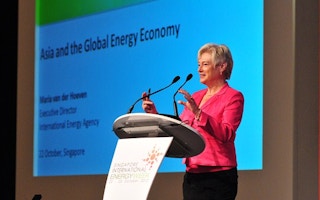Asia will be hard-pressed to adapt to its changing energy needs without a natural gas trading hub, said the head of the International Energy Agency in Singapore on Monday.
In her opening keynote speech at the Singapore International Energy Week at the Sands Convention and Expo Centre, IEA executive director Maria van der Hoeven said that natural gas was the only option for Asia to transition to a clean energy economy and that the “one fundamental thing…missing” was a regional trading hub.
Singapore would have major advantages as a hub because of its key location, oil trading experience and advanced institutions, she added.
The IEA will release a report early next year with recommendations for an Asian gas trading hub, which she said would help lower the region’s disproportionately high prices and ensure fair access to resources.
Asia is the second largest gas consuming region, and demand is rising quickly. The liquefied natural gas (LNG) market alone is expected to expand by a third from 2011 to 2017, according to the IEA. LNG is natural gas that has been chilled to liquid form in purpose-built terminals for easy transport. Countries with no access to natural gas pipelines can import LNG if they build a receiving terminal.
Singapore is currently building an LNG terminal to be operational next year, and may soon be competing with India, China, Thailand, Malaysia, Vietnam and potentially the Philippines for LNG supplies.
Competition from within Asia for LNG supplies will be fierce, Ms van der Hoeven noted, but explained that natural gas – along with renewable energy technologies - was key to breaking Asean’s growing, unsustainable dependency on coal as it pursues “massive electrification”.
The IEA’s Energy Technology Perspective, released in June, outlined a plan for Asean to achieve an energy mix with more than 80 per cent natural gas and renewable energy by 2050.
“Achieving those levels will be very, very challenging…Fortunately, the Asean region has large untapped (renewable energy) resources,” she said, referring in particular to Indonesia’s burgeoning geothermal industry.
IEA energy analyst Steve Heinen said last week in Brussels that while gas needed to be viewed as a bridge fuel to reach the 2050 low-carbon energy scenario, it would not remain a low-carbon option in the long-term. As standards rise, in about 2025, it will be viewed as a high-emission fuel unless accompanied by carbon capture and storage (CCS) or other carbon-reducing technologies, he was reported as saying by industry publication Gas to Power Journal.
Ms van der Hoeven noted that while the renewable energy technologies for the future energy mix are making progress – global capacity will grow 40 per cent from 2011 to 2017, led by China – policies to support that growth are trailing behind. She explained that countries needed well-thought policies based on an evaluation of the entire electricity system and not just individual technologies.
With that, and with investment in smart grids and an Asean power grid, the region will be “ripe for leap-frogging”, she said, referring to the ability to build on lessons learnt from experiences in other regions.
For example, she said that Asia could avoid the mistakes made by Spain, which built up renewable energy capacity without having sufficient grid infrastructure to support it.
However, she reminded the group of 1,000 policymakers, business professionals, NGOs and academics, the most affordable and most effective tool to achieve policy goals is often energy efficiency.
More than half of carbon reductions will come not from new energy supplies, but from energy efficiency improvements in the transport, building and energy sectors, she said, noting that better energy efficiency also has implications for energy security.
“The most secure barrel or kilowatt will always be the one we don’t use,” she said.
The current global economic slowdown has created uncertainty that is not going away anytime soon, resulting in a “new reality of risk”, she added.
Governments can set the right policies, but the private sector will have to provide most of the capital and investment to cope with this new reality, said Ms van der Hoeven, noting that cooperation will be necessary to provide security.
“The global energy map is changing and we need to work together to change with it,” she said.








